The holiday season is a time for warmth, gathering, and indulging in the kind of food that not only nourishes the body but also brings people together. Among the hearty casseroles, vibrant salads, and sweet confections that typically fill the Christmas table, soup often plays a supporting role. However, in recent years, vegan Christmas soup has taken center stage for many households committed to health-conscious and plant-based lifestyles. Offering a comforting, flavorful, and nutrient-dense option, festive vegan soup can be more than just an appetizer—it can be a celebration of seasonal abundance, culinary creativity, and nutritional wisdom.
You may also like: Healthy Plant-Based Dinners Made Easy: Best Whole Food Plant-Based Recipes for Beginners and Beyond
The appeal of vegan Christmas soup lies in its unique ability to fuse tradition with innovation. Classic holiday ingredients such as root vegetables, winter greens, legumes, and warming spices lend themselves beautifully to plant-based preparations. At the same time, culinary creativity allows for bold new flavor profiles and nutrient-packed combinations that go beyond conventional soup recipes. Whether served as a cozy starter or a main course with artisanal bread, festive vegan soup has evolved into a sophisticated dish that satisfies both palate and principles.
Nutritionally, soups made with whole, plant-based ingredients deliver a spectrum of health benefits that align with the core values of the Whole-Food Plant-Based Nutrition and Plant-Based Health movements. These soups are typically rich in fiber, phytonutrients, vitamins, and minerals while being naturally low in saturated fat and devoid of cholesterol. Furthermore, the gentle cooking methods associated with soup preparation help retain the integrity of these nutrients, making each bowl a valuable source of wintertime wellness. When crafted with intention, these soups nourish not only the body but also the mind, offering a soothing antidote to the holiday stress many people experience.
At a deeper level, embracing festive vegan soup for your Christmas table represents a conscious choice toward sustainable eating. By minimizing reliance on animal products and emphasizing seasonal, locally sourced vegetables, legumes, and grains, these recipes align with ecological principles that support planetary health. Moreover, they accommodate a diverse range of dietary needs and preferences, making them inclusive and welcoming to a wide audience. This inclusivity reinforces the holiday spirit of generosity and connection.

From a culinary perspective, vegan soups offer an endless canvas for experimentation. The interplay of textures—from silky purees to chunky stews—and the layering of flavors through herbs, spices, and umami-rich ingredients such as miso or nutritional yeast provide remarkable depth and satisfaction. Whether it’s a spiced butternut squash bisque infused with ginger and coconut milk or a rustic lentil and kale soup with hints of rosemary and smoked paprika, each recipe can be tailored to reflect personal taste while staying rooted in tradition.
Understanding the key components of a well-balanced festive vegan soup is essential for creating dishes that are both satisfying and nutritionally complete. Proteins often come from legumes such as lentils, chickpeas, or black beans, which provide not only essential amino acids but also fiber and minerals like iron and magnesium. Vegetables such as carrots, parsnips, leeks, and Brussels sprouts add texture, flavor, and vitamins, while complex carbohydrates from whole grains like barley, quinoa, or brown rice contribute to long-lasting satiety. Incorporating healthy fats—whether from nuts, seeds, or avocado—enhances the absorption of fat-soluble vitamins and adds richness to the dish.
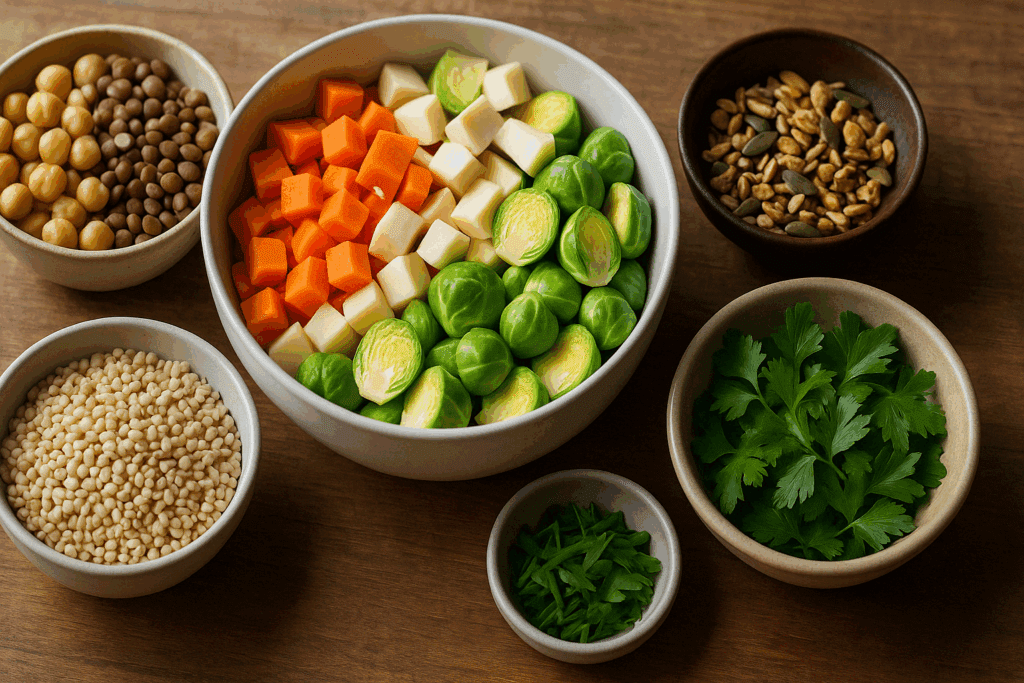
Spices and herbs play a pivotal role in elevating festive vegan soup beyond mere sustenance. Traditional holiday spices like cinnamon, nutmeg, cloves, and allspice can introduce warmth and aromatic complexity, especially when balanced with savory elements such as garlic, thyme, and bay leaves. Fresh herbs like parsley, sage, rosemary, and thyme not only provide a flavor boost but also offer anti-inflammatory and antioxidant properties that align with the goals of plant-based health. A splash of citrus or vinegar at the end of cooking brightens the flavors, while garnishes such as roasted seeds, toasted sourdough, or a swirl of cashew cream add visual appeal and textural contrast.
Incorporating global influences can further expand the festive vegan soup repertoire. For instance, a North African-inspired harira, brimming with lentils, tomatoes, and warming spices, brings depth and cultural richness to the holiday menu. A Thai-style coconut curry soup with lemongrass, lime leaves, and tofu offers a vibrant counterpoint to traditional Western fare. Eastern European borscht, with its vivid color and earthy flavor, provides a stunning visual and gustatory experience that’s perfect for special occasions. By thoughtfully incorporating such influences, cooks can craft a diverse and celebratory soup menu that resonates with the global nature of plant-based eating.
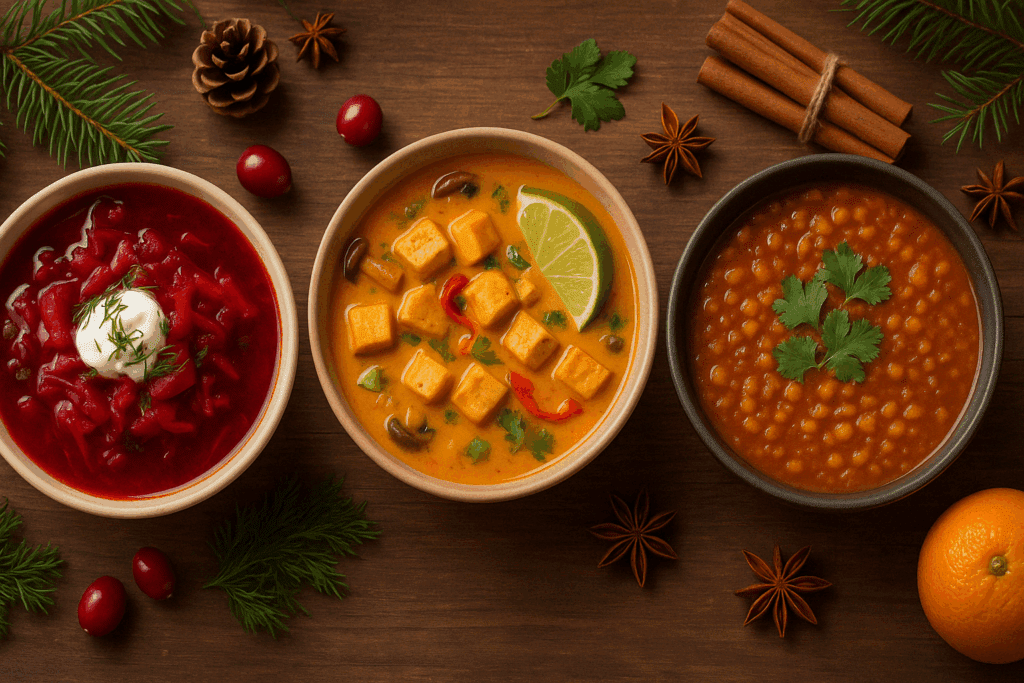
In addition to taste and tradition, the health implications of vegan Christmas soup deserve careful consideration. Multiple studies support the health benefits of plant-based diets, particularly when focused on whole foods rather than processed alternatives. These diets have been associated with reduced risks of chronic diseases such as cardiovascular disease, type 2 diabetes, and certain cancers. The high fiber content in legumes and vegetables helps regulate blood sugar levels and promotes gut health, while the absence of animal fats reduces the intake of saturated fats that are linked to inflammation and arterial plaque buildup.
Furthermore, festive vegan soup supports immune health—an especially pertinent concern during the winter months when colds and flus are more prevalent. Many of the ingredients commonly used in these soups, such as garlic, onions, turmeric, and leafy greens, have immune-modulating effects. Vitamin C from vegetables like bell peppers and kale, as well as zinc from pumpkin seeds and legumes, contribute to immune resilience. In this way, a warm bowl of soup becomes more than a culinary comfort—it transforms into a tool for proactive health maintenance.
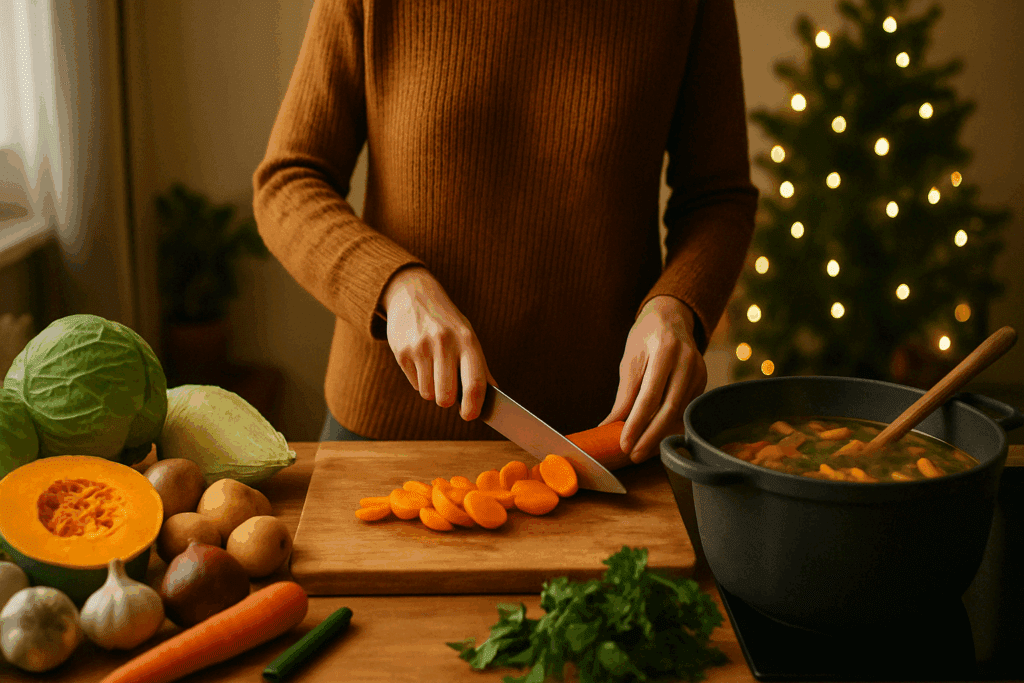
Creating vegan Christmas soup from scratch also fosters mindfulness and intentionality in the kitchen. The act of washing, chopping, simmering, and tasting connects the cook with the ingredients and the process, cultivating a sense of presence and gratitude that mirrors the spirit of the holidays. Cooking can become a meditative practice that encourages slower living, especially important in a season often marked by consumerism and rush. This slower, more intentional approach to meal preparation not only enhances the quality of the final dish but also strengthens the emotional and social bonds created around the table.
To maximize the nutritional impact and culinary satisfaction of festive vegan soup, it is important to be selective with ingredients. Choosing organic produce when possible reduces exposure to pesticides, while prioritizing whole, unprocessed ingredients helps maintain nutrient density. Preparing stocks from scratch using vegetable scraps can reduce food waste and enhance flavor. Seasoning with sea salt or miso instead of highly processed bouillon cubes avoids unnecessary additives, and cooking in stainless steel or ceramic pots instead of non-stick cookware minimizes exposure to harmful chemicals.
When serving soup as a centerpiece of the holiday meal, presentation becomes especially significant. A thoughtfully garnished bowl can evoke a sense of occasion and celebration. Consider layering textures and colors by adding toppings such as pomegranate seeds, microgreens, or roasted chickpeas. Drizzling with a contrasting sauce—like a basil pesto or harissa oil—can add visual drama and a burst of flavor. Serving soup in warmed bowls, accompanied by artisanal breads or grain-based side dishes, completes the sensory experience and makes the meal feel truly festive.
Leftovers from festive vegan soup can also serve as the foundation for subsequent meals, reducing food waste and simplifying post-holiday cooking. Leftover lentil soup can be thickened and served over rice or baked potatoes. Pureed vegetable soups can be used as a sauce for pasta or grain bowls. Even chilled, some soups like gazpacho or beet-based varieties maintain their appeal, especially when paired with fresh herbs and a squeeze of lemon. Repurposing leftovers in creative ways ensures that the effort invested in preparing these nourishing dishes continues to provide value beyond the holiday meal itself.
As public interest in plant-based eating continues to grow, festive vegan soup is increasingly being recognized as a powerful symbol of healthful celebration. Its ability to embody culinary tradition, seasonal consciousness, and nutritional integrity makes it uniquely suited for the modern Christmas table. Whether you are hosting a formal dinner, contributing to a holiday potluck, or simply preparing a comforting meal for loved ones, a thoughtfully crafted vegan Christmas soup can elevate the experience and create lasting memories.
It is worth noting that the concept of festive vegan soup transcends mere dietary choice—it reflects a broader lifestyle commitment to sustainability, compassion, and holistic wellness. By centering your holiday menu around plant-based dishes, you not only nourish your body but also support ethical food systems and environmental stewardship. This alignment of personal and planetary health embodies the true spirit of the season, which values generosity, empathy, and connection.
From a culinary education perspective, the process of developing festive vegan soup recipes also serves as an opportunity to deepen one’s skills in flavor balancing, texture contrast, and ingredient sourcing. Learning to work with plant-based thickeners like pureed beans or cashews, understanding the role of acids in brightening flavor, and mastering techniques like slow simmering or roasting vegetables before adding them to the pot all contribute to a richer understanding of whole-food plant-based nutrition. These skills can then be applied throughout the year, reinforcing long-term dietary habits that promote health and vitality.
As more households seek inclusive meal options that cater to various dietary needs—whether for vegans, vegetarians, or those managing chronic health conditions—the versatility of festive vegan soup becomes increasingly valuable. These dishes are inherently free from common allergens such as dairy and eggs and can be adapted to be gluten-free or low-sodium as needed. This flexibility ensures that everyone at the table can partake in the meal without compromise, reinforcing the communal essence of holiday dining.
Moreover, festive vegan soup can be a gateway for introducing plant-based eating to skeptical or unfamiliar guests. A well-seasoned, beautifully presented soup that delivers complex flavor and hearty satisfaction can dispel myths about vegan food being bland or insubstantial. Serving these dishes in a joyful, convivial setting allows the flavors to speak for themselves and may inspire curiosity or even conversion among friends and family members.
In the spirit of giving, many individuals and organizations also use the holiday season as an opportunity to serve vegan soup to those in need. Soup kitchens, shelters, and community events often feature plant-based options that are easy to prepare in large quantities, affordable, and accessible. Volunteering to prepare or serve vegan Christmas soup can thus become a meaningful way to contribute to the community and embody the values of empathy and care that underpin both the holidays and plant-based living.
Ultimately, embracing festive vegan soup as part of your Christmas celebration is a decision rooted in intention, creativity, and care. It reflects a desire to honor your health, the environment, and the well-being of those around you. As you plan your holiday meals, consider the transformative potential of this humble yet profound dish. In every spoonful, you’ll find not only the flavors of the season but also the essence of a lifestyle that prioritizes nourishment, sustainability, and joy.
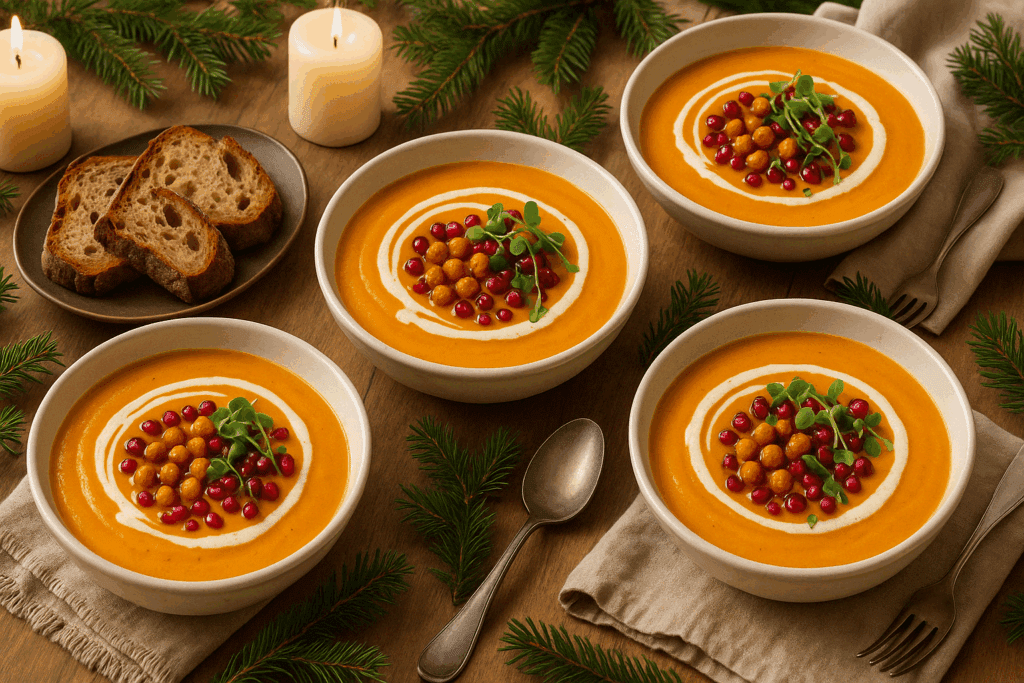
Frequently Asked Questions (FAQ) on Festive Vegan Soup and Vegan Christmas Soup
What are some uncommon ingredients that can elevate a festive vegan soup to gourmet status?
To transform a standard vegan Christmas soup into a gourmet experience, consider using ingredients that provide depth, aroma, and visual intrigue. Black garlic, with its sweet umami flavor, introduces an unexpected richness that pairs well with root vegetables and legumes. Sunchokes (Jerusalem artichokes) add a nutty complexity and creamy texture when pureed, while foraged mushrooms such as chanterelles or maitake introduce earthy, woodsy notes that resonate with winter themes. A splash of white truffle oil or a sprinkle of sumac just before serving can elevate the flavor profile without overwhelming it. These refined touches turn an everyday festive vegan soup into a centerpiece dish worthy of holiday acclaim.
How can you incorporate protein-rich elements into a festive vegan soup without using processed meat substitutes?
While processed vegan meats may offer convenience, whole-food sources of plant protein contribute superior nutrition and texture. Lentils, black-eyed peas, and cannellini beans are not only hearty but provide complete protein when combined with grains like barley or farro in your vegan Christmas soup. Silken tofu can be blended into broths to add creaminess and subtle body, while tempeh cubes, when marinated and pan-seared, introduce satisfying chew and a slight nutty flavor. Another underutilized ingredient is hemp seeds—they blend smoothly into purees and subtly enhance the nutritional profile with omega-3s and all nine essential amino acids. These options allow you to craft a festive vegan soup that supports muscle repair, satiety, and long-lasting energy.
Can festive vegan soup be made in advance without sacrificing flavor or texture?
Absolutely. In fact, many vegan Christmas soup recipes benefit from being made a day or two in advance, as resting allows flavors to deepen and meld. To preserve texture, particularly with green vegetables or grains, consider undercooking these components slightly when preparing ahead of time. Before serving, reheat gently on low heat to avoid overcooking or mushiness, and add fresh herbs or a splash of acid like lemon juice to brighten the dish. Soups featuring coconut milk or nut creams can sometimes thicken upon cooling; simply whisk in a bit of vegetable broth to restore the desired consistency. By planning ahead, you reduce holiday stress and improve the overall culinary experience.
What are some festive vegan soup pairings that enhance a multi-course holiday menu?
Pairing your vegan Christmas soup with complementary sides or courses can create a cohesive and memorable dining experience. For example, a creamy chestnut and cauliflower soup pairs beautifully with a tart cranberry chutney crostini or a roasted beet salad. If serving a spiced lentil festive vegan soup, follow with a main course of walnut-stuffed acorn squash or rosemary-roasted root vegetables. To balance richer soups, consider a zesty palate cleanser like citrus-marinated fennel or an herbed cucumber salad. These combinations enhance visual appeal, stimulate the palate, and reinforce seasonal harmony across your holiday menu.
How can festive vegan soup support mental wellness during the holidays?
Beyond physical nourishment, vegan Christmas soup can support emotional well-being through its calming and restorative qualities. Ingredients like magnesium-rich leafy greens and vitamin B6 from chickpeas are linked to mood regulation and reduced anxiety. The act of preparing soup—chopping, simmering, stirring—can serve as a grounding, meditative ritual that counters holiday overwhelm. Aromatic herbs such as sage and rosemary have been shown to reduce cortisol levels and improve cognitive clarity, making their inclusion in festive vegan soup not just culinary but therapeutic. Sharing a warm, nutrient-dense soup with loved ones also fosters social connection, which plays a crucial role in managing seasonal stress and loneliness.
What are some advanced culinary techniques that can enhance vegan Christmas soup?
Professional chefs often apply advanced methods to coax deeper flavors from plant-based ingredients. Roasting vegetables like squash, garlic, or tomatoes before adding them to your festive vegan soup intensifies sweetness and umami. Deglazing the pot with a splash of wine or sherry after sautéing onions and aromatics adds nuanced depth. Try emulsifying a portion of the soup using an immersion blender for a creamy body while retaining some chunks for texture. For a refined finish, make an infused oil with herbs or spices to drizzle over the top. Techniques like these bring a restaurant-level polish to your vegan Christmas soup without requiring animal-based ingredients.
How can I create a globally inspired festive vegan soup that still feels seasonal?
A great way to craft a globally inspired vegan Christmas soup is to blend cultural flavor profiles with traditional winter ingredients. For example, an Italian ribollita made with Tuscan kale and cannellini beans becomes holiday-appropriate when spiced with nutmeg and garnished with roasted chestnuts. A Moroccan-style harira infused with cinnamon and ginger can feel festive when paired with seasonal squashes and fresh parsley. Even an Indian-inspired mulligatawny with apples, lentils, and warming curry spices captures the essence of a winter celebration. These variations allow you to celebrate the richness of international cuisine while honoring the festive vegan soup tradition in a culturally sensitive and inclusive way.
What storage and freezing tips ensure that leftover vegan Christmas soup maintains its quality?
To preserve both flavor and nutritional integrity, allow festive vegan soup to cool completely before transferring it to airtight containers. If you plan to freeze portions, avoid adding ingredients like fresh herbs or coconut milk until reheating, as these can lose texture or separate. Label containers with the date and type of soup, and store in the freezer for up to three months. When reheating, do so slowly over medium heat, stirring frequently to prevent separation or scorching. Add a splash of lemon juice or a handful of fresh greens just before serving to restore brightness and freshness to your vegan Christmas soup.
How can children and picky eaters be introduced to festive vegan soup during the holidays?
Introducing children to festive vegan soup can be both fun and rewarding when approached creatively. Begin with familiar flavors and textures—such as creamy sweet potato soup or carrot-ginger blends—then gradually incorporate more complex ingredients. Offering toppings like crunchy croutons, colorful veggie chips, or a swirl of dairy-free cream gives children a sense of involvement and personalization. Storytelling around ingredients (e.g., “This is Santa’s favorite carrot soup”) adds whimsy and engagement. Making soup together as a family also fosters curiosity and willingness to try new dishes, making vegan Christmas soup a tradition that grows with your child.
What trends in plant-based cuisine are influencing the future of vegan Christmas soup recipes?
Emerging culinary trends are redefining what festive vegan soup can look like. Fermented elements like miso, kimchi juice, or pickled mustard seeds are being incorporated for gut health and bold flavor. There’s also a growing interest in regenerative agriculture, prompting cooks to use regionally grown, soil-enriching crops such as lentils or cover crops in their soups. Tech-enabled cooking tools like precision blenders and induction cookers are making it easier to achieve perfect textures and controlled simmering. Finally, the rise of zero-waste cooking encourages use of whole vegetables—including stems, peels, and cores—turning what was once discarded into deeply flavorful broths. These shifts suggest that the evolution of vegan Christmas soup will be as dynamic and diverse as the communities who prepare and enjoy it.
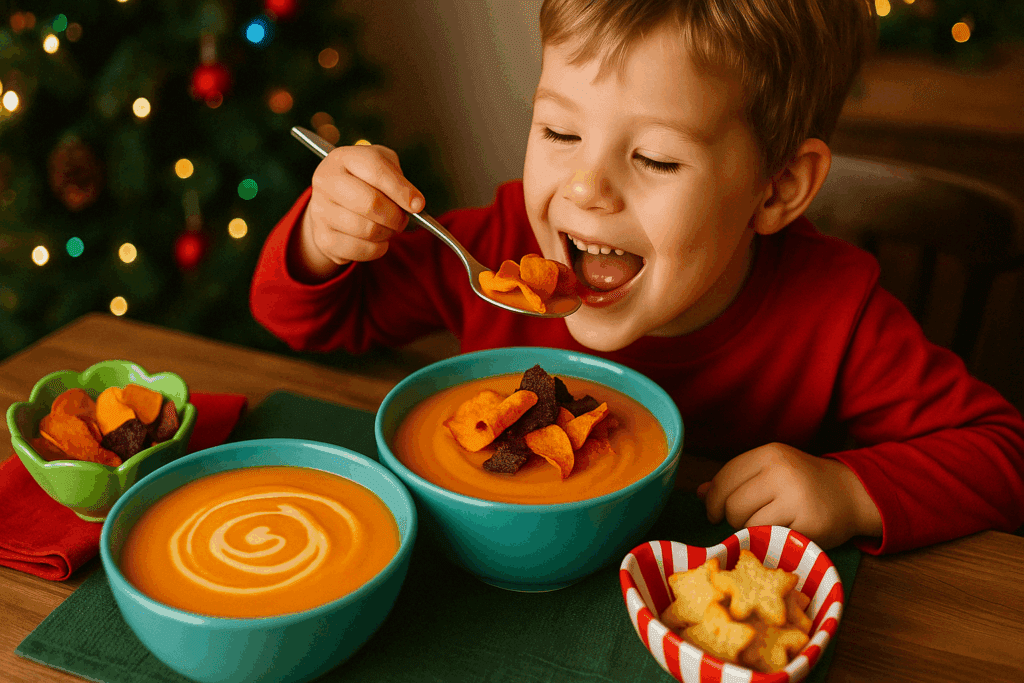
A Warm Closing Reflection on the Joy of Festive Vegan Soup
As the snow settles and holiday lights twinkle, the aroma of a simmering vegan Christmas soup can evoke comfort, nostalgia, and a sense of homecoming. More than just a dish, festive vegan soup is a culinary expression of love, health, and mindfulness. Its warmth transcends the bowl, offering solace against winter’s chill and bringing people together in shared celebration. Whether you’re crafting a bold new recipe or honoring a cherished family tradition with a plant-based twist, this humble dish can anchor your Christmas table in meaning and intention. Let each ingredient, each stir of the pot, and each shared bite remind you that joy can be found in the simplest of moments—and that nourishment, when approached with care, can be a powerful act of holiday grace.

